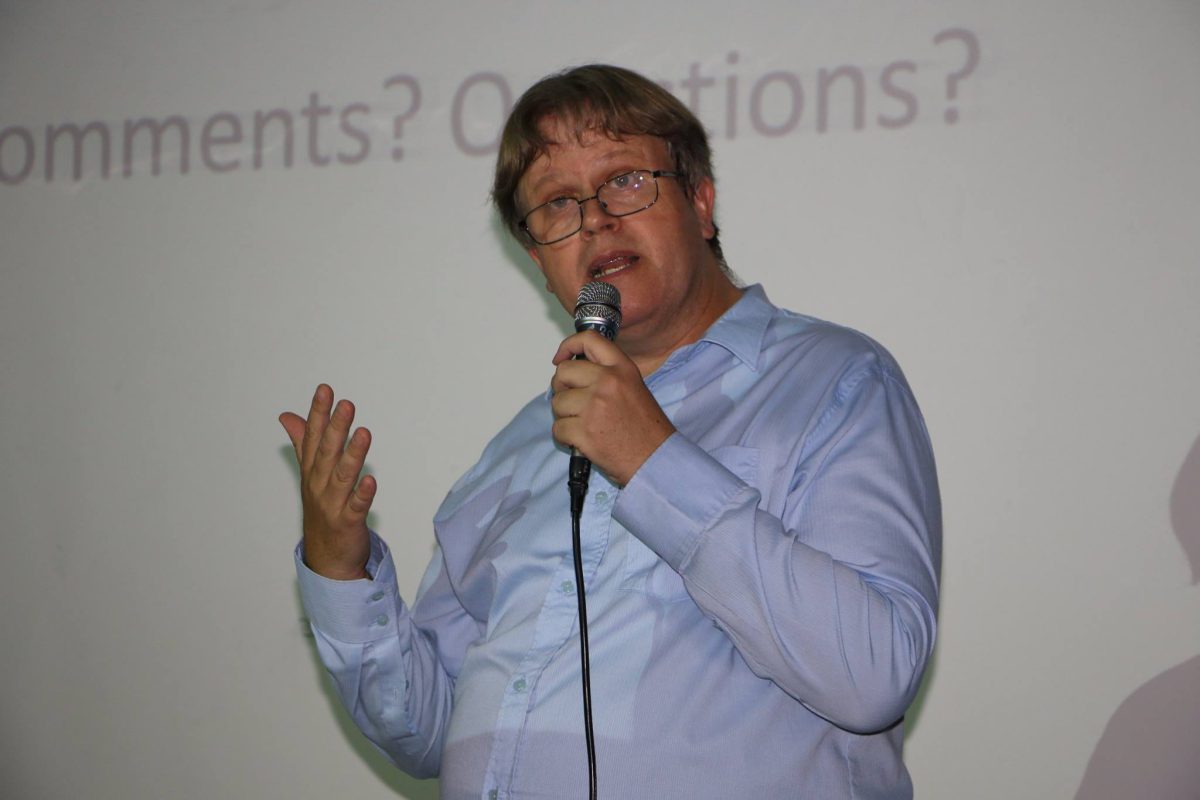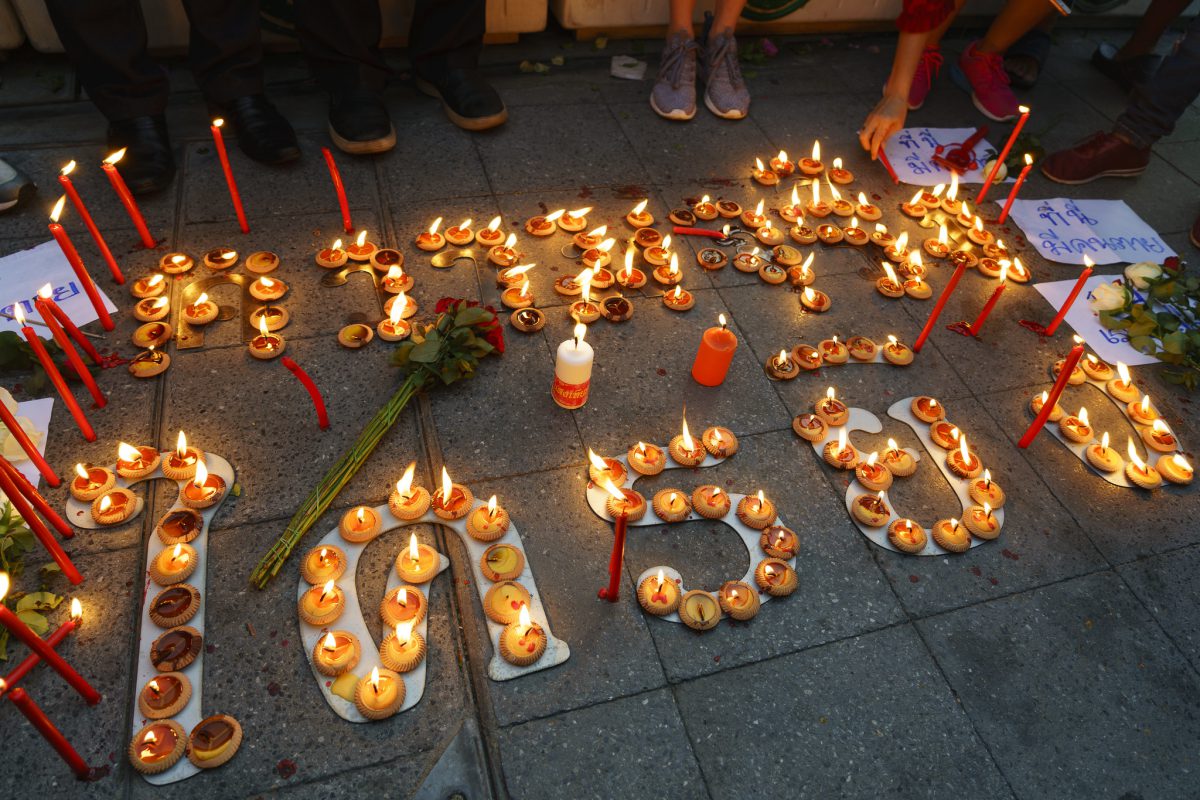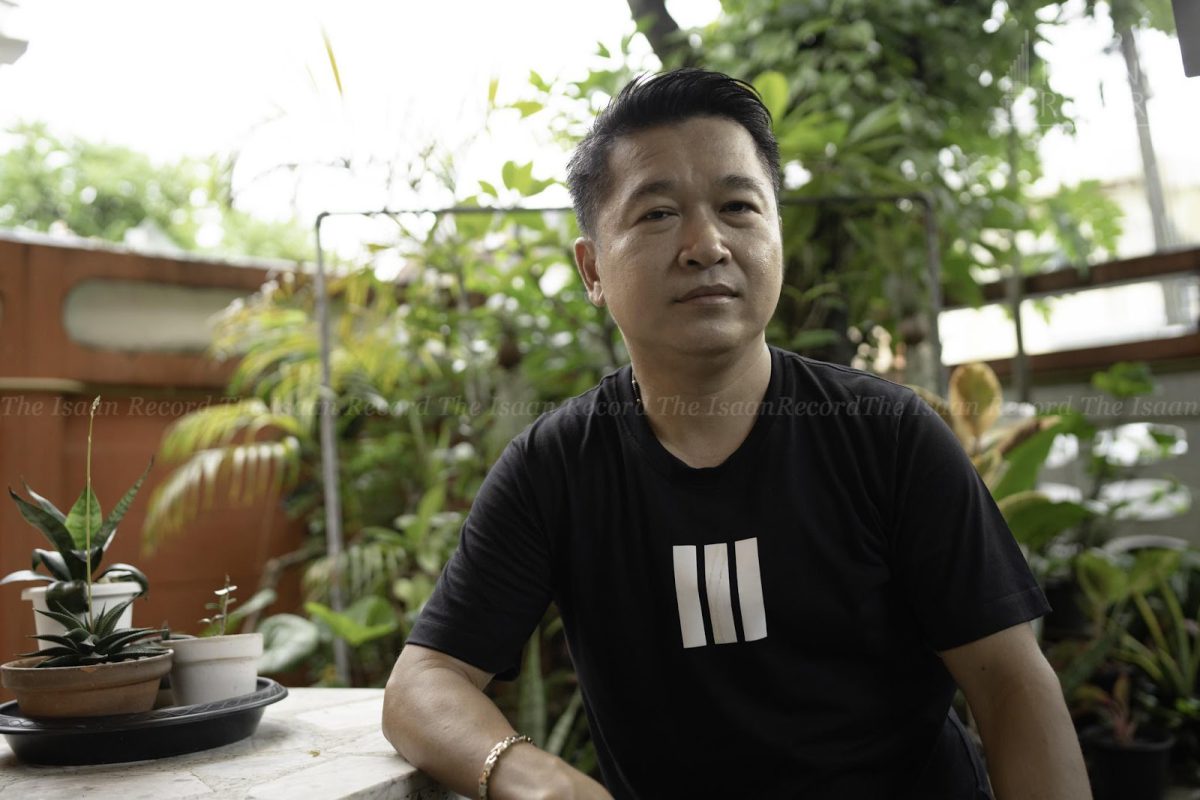In a conversation with Apichatpong Weerasethakul, the filmmaker talks about his contribution to the film Ten Years Thailand, a new documentary project, the changing art scene and his concerns for Thailand’s political future.
The lobby of the new design center TCDC Khon Kaen is swarming with security guards in mid-January as filmmaker Apichatpong Weerasethakul sits down for an interview with The Isaan Record. Outside, the center’s first official event is in full swing but the guards are keeping curious visitors from entering the newly constructed but not-yet-opened building.
Apichatpong, who grew up in Khon Kaen, is here to give a talk (see video below) at the screening of Ten Years Thailand, a new anthology film that offers a dark critique of Thai society and politics.

IR: For Song of the City, your contribution to Ten Years Thailand, you returned to the Northeast. Just like your last feature film, Cemetery of Splendour, the new short film is set in Khon Kaen. What keeps you coming back to your hometown?
A: When you think about the future, you always have to track back to the past and I feel like my other films have also followed this idea. I’m always thinking about the future and for Ten Years Thailand it was an obvious approach. Khon Kaen’s monument to Sarit [Field Marshal Sarit Thanarat, military dictator in the 1950s/60s] has been featured before in my recent works.
In Song of the City, I wanted to tackle the topic more directly with him as the main focus. I planned to take an open approach to go to Khon Kaen and see what’s going on. I think a month or two before the shooting, I realized that the Sarit monument was under construction. But we shot anyway because I thought that the construction workers wearing red shirts was very interesting.
But the initial idea actually was to film the statue of Sarit and then gradually erase him digitally, to make him slowly disappear. But when I saw these workers and the dust on the construction site, I thought it’s more interesting to make it very simple, and gather people around who represent the idea of certain memories; actors, and people like Patiwat “Bank” Saraiyaem.
IR: Bank is a mo lam artist and activist from Sakon Nakhon who spent time in prison for his role in a play to commemorate the 40th anniversary of the popular uprising in 1973. Why did you cast him for this film?
A: I actually don’t remember why originally, but I know that I wanted to work with him before this project. We met through a friend and started talking a month before the shoot.
IR: What is it about Isaan that you keep placing things here? Is there something here that you can’t do somewhere else. Is there an answer you are looking for here?
A: I have worked before in Khon Kaen, Nong Khai, Nakhon Phanom, Sakon Nakhon, Chaiyaphum, and Loei. But I grew up in the hospital area in Khon Kaen City, in a Chinese family with a very comfortable middle-class life.
But it is still a bubble; in the hospital, in the education system, and in Khon Kaen itself. There are different layers of walls. So I feel that coming here with the camera is to find, or to learn something outside these bubbles.
When we make films, it’s impossible to present the truth, The same is true for texts. It’s all subjective, I think, because there so many different voices. But of course there is only one voice in the [history] textbooks, which is very scary. Even today, there are so many things that are not mentioned.
In Isaan you get a clear idea of the system. Because you know about some events, the violence that occurred in the past. And it‘s all tied with the US, Bangkok, the Cold War, everything is connected. By starting at home you start to see other pictures, larger pictures. I don’t know, I don’t think it’s about answering any question. There’s no truth.
Making films is a very pleasant way to look and learn, to go through different sources of information and voices. But I‘m not an activist, you know, I just go by my gut feeling and whatever I feel is enjoyable.
IR: In an interview in 2015, you told us that Thailand felt like a ship that is sinking, but the ship is very comfortable and there’s lots of food and music, people are partying. Would you say the same today, is the ship still sinking?
A: I think so…I’m not sure. I don’t know if there is a way to get rid of the non-democratic system, or the beliefs of the people.
In Thailand, the political theater is so obvious when you look at what Prayuth [Chan-ocha] is doing. But it’s like people don’t believe it or they don’t care. I think people, deep down, know that it’s a joke. At least in Chiang Mai where I live, people and the villagers know it. The people around there are so fed up with the military and their plans, the idea of pracha-niyom and everything.
From the beginning of modern history in 1932, we have always had the military. I think almost every province has a military camp, maybe one or two don’t, but they do have some presence of the military. So it’s been a military state from the beginning.
IR: Why do you often include references to Thailand’s communist movement in your work?
A: Because I feel that we should have a communist party or at least keep it like a symbol for people to learn about the ideology. A different ideology to understand the world. Allowing people to have this kind of party would be really important.
IR: What do you think about the new political parties?
A: I like the Future Forward Party. But I wish they are more clear about the issue of the monarchy. But then, maybe, they are just a lot smarter than I am [laughs] because they will have to form coalitions with other parties.

IR: How does Thailand compare to Colombia where you are working on your new film?
A: It’s very chaotic and violent, and I think it might make me appreciate Thailand more. Working there is very fascinating and at the same time you see more of the people’s struggle.
Colombia makes me think about myself. I think we are trained to be submissive, and I myself, I cannot help it. It’s in the DNA, since I was a kid it was instilled in us how to be an obedient subject.
Being in Colombia and seeing people in Latin America so aggressively fighting for their rights and building a culture of resistance… Their methods and approaches has been developed and are very advanced.
In Thailand, we never had any chance to develop, so it’s no wonder that there were many burning buildings in central Bangkok [in 2010], because people haven’t learned how to protest properly and resist. Also, the government hasn‘t learned anything, so they kill. Or maybe this is the way that we are learning but it’s very slow. And it’s not a lesson taken from global events.
Latin America has had a lot of political art for a long time already. They have so much political art that it almost numbs you.
I actually think it’s a healthy situation in Colombia but here in Thailand it’s not like that. There are no such art works and so there is no dialogue at all.
IR: In the situation now, especially as you compare it to Columbia, is art possible, is making film possible, is literature possible in Thailand?
A: Art is possible, and the more I’ve been working in Columbia, the more I want to come back because there are so many topics here. I also feel there is some protection. Like The Isaan Record, there are still some independent spaces. Like what we saw in the case of the Saudi woman, this Twitter thing, it’s getting more difficult to suppress things.
But still [there are] certain subjects that you cannot touch. At the same time there are other interesting subjects like with Patiwat, Bank, who is an interesting case, looking at his life, as a documentary subject.
For the country as a whole, I still remain not hopeful. In terms of expression, it’s okay, but again, I don’t view my work as something that will cause change’ it’s just my personal expression.
IR: Are you considering to produce another feature length film set in Isaan? What else are you working on?
A: I am dreaming about it and I am currently working on a documentary film unit which is based in Chiang Mai. It is not only going to be me as a director but more of a collective.
We had a first screening a few weeks ago as a starting point. We will work with Ajaan Puangthong Pawakapan on a documentary about October 6 [1976], which is a very symbolic date that has already been discussed in public a lot.
I recently went to Gwangju in South Korea where they have a museum exhibiting a lot of a artifacts, records, newspaper clippings — really everything about the May event [Gwangju Uprising or May 18 Democratic Uprising in 1980]. But here, people still censor themselves when they talk about the October 6 event even though it’s a very important date, just like October 14 [1973]. It is not mentioned in the school textbooks so I believe that there is a lot more we have to do.
Although sometimes I am bit bored by it, I think it’s urgent because the witnesses of this event are dying and there are only a few left.

Last week, Apichatpong was awarded the prestigious 2019 Artes Mundi prize held by the National Museum Cardiff in Wales.
IR: Where do you see Isaan in ten years?
A: I think in ten years, Isaan will be very prosperous, but I am not sure if I will like it. Because I already don’t like the way the region is developing now.
Only look at the area around the Sarit monument [in the city center of Khon Kaen] — it is like for ghosts [laughs]. There are very few trees, and it’s not made for the people. Many places are only made for middle-class people, for the people who can afford it.
But that’s what it’s going to be and the middle class here will be packed with power, which you can already see. And there might be justifications for a non-democratic system then. People might be happy with that, with the China Model, as long as their materialism is satisfied.
I am sure it will still be authoritarian and there might even be more subtle control of the people.
What I also find very interesting is…imagine how many mixed children and Thai-foreign couples there are in Isaan. They put their kids into good international schools and that will cause quite a change here.
IR: Have you ever considered artistically the issue of decentralization or breaking free from the powers of the center?
A: All the time, because growing up here, it was even more pronounced than now. There were many things that you had to go to Bangkok [for], including knowledge, for example, about architecture. I had to go to a tutor school there in order to come back here and apply to study. Everything was so dependent and I hated these feelings.
And it’s not only me but many people in my generation. When we went to Bangkok, we felt quite ashamed to say “I am from Khon Kaen.” But it is not like that anymore, I think. With the internet and capitalism, you don’t need a center anymore.
IR: Do you think the art scene has changed much in the past five years?
A: I think so. People are so trained in a certain understanding of what art is supposed to be. Physical beauty is super important and anything linked to religion. This understanding is breaking up, which is directly related to political movements, I think. It’s a political awakening. Ten Years Thailand is an example of that change.
But at the same time, it is a frustrating condition because we are programed to be submissives and, at the same time, we know it. I believe social media helps as a release for people. It’s a way for people to get information that was once hard to get. But at the same time it doesn’t seem to get in touch with the real political world –especially not those “dinosaurs” [laughs].
IR: Do you think your art concerns the powers that be?
A: Not yet, because I think my work is not really designed to instigate people. It’s not dangerous. The people in power have yet to raise to the level of understanding of art of the Chinese regime.
If I look at the China Model, at one point they were pretty free with the arts but now not anymore. Today, when we talk about Chinese contemporary arts, it’s all about politics and they [the authorities] now know all about it.
IR: Does the use of art by activists democratize art in Thailand?
A: I hope so, because for me good art is supposed to generate friction. It is supposed to make people think and argue. If activists use art it will naturally lead to that. At the same time, I believe that art is about reduction and that abstraction makes people understand the larger context. That is the beauty of art.




